Abstract
Faecal oral spread is claimed by many to be the mode of transmission of the gastric pathogen Helicobacter pylori. This idea is based not on experimental data but because the epidemiology of H. pylori infection resembles that of other pathogens known to be spread by the faecal-oral route. This is in spite of the observation that no-one has been successful in culturing H. pylori from human stool. In this study, a series of transmission experiments are reported on animals infected with the gastric spirilla, Helicobacter felis and 'Gastrospirillum hominis'. Germfree mice and rats infected with H. felis did not transmit their infection to uninoculated mice despite prolonged contact in the same cage nor could the bacterium be isolated from their intestinal contents. This was confirmed in specific pathogen free mice where infected dams did not pass the helicobacter to their progeny. Similarly, mice infected with a human isolate of 'Gastrospirillum hominis' did not transmit the infection while in close contact with uninoculated mice. In contrast, in a limited series of experiments, both H. pylori and H. felis were transmitted from infected gnotobiotic Beagle puppies to uninfected animals in the same enclosure. In addition, the gastric mucus from a cat with indigenous 'Gastrospirillum'-like organisms was infectious for mice, whereas faecal content from the same animal was not. It is suggested that the difference between the murine and canine experiments is that the dogs are more likely to have oral-oral contact than rodents. Unlike dogs, mice and rats do not vomit and are coprophagous. It is concluded that the case for faecal-oral spread of Helicobacter species is 'not proven' and that the inter-oral route is more likely.
Full text
PDF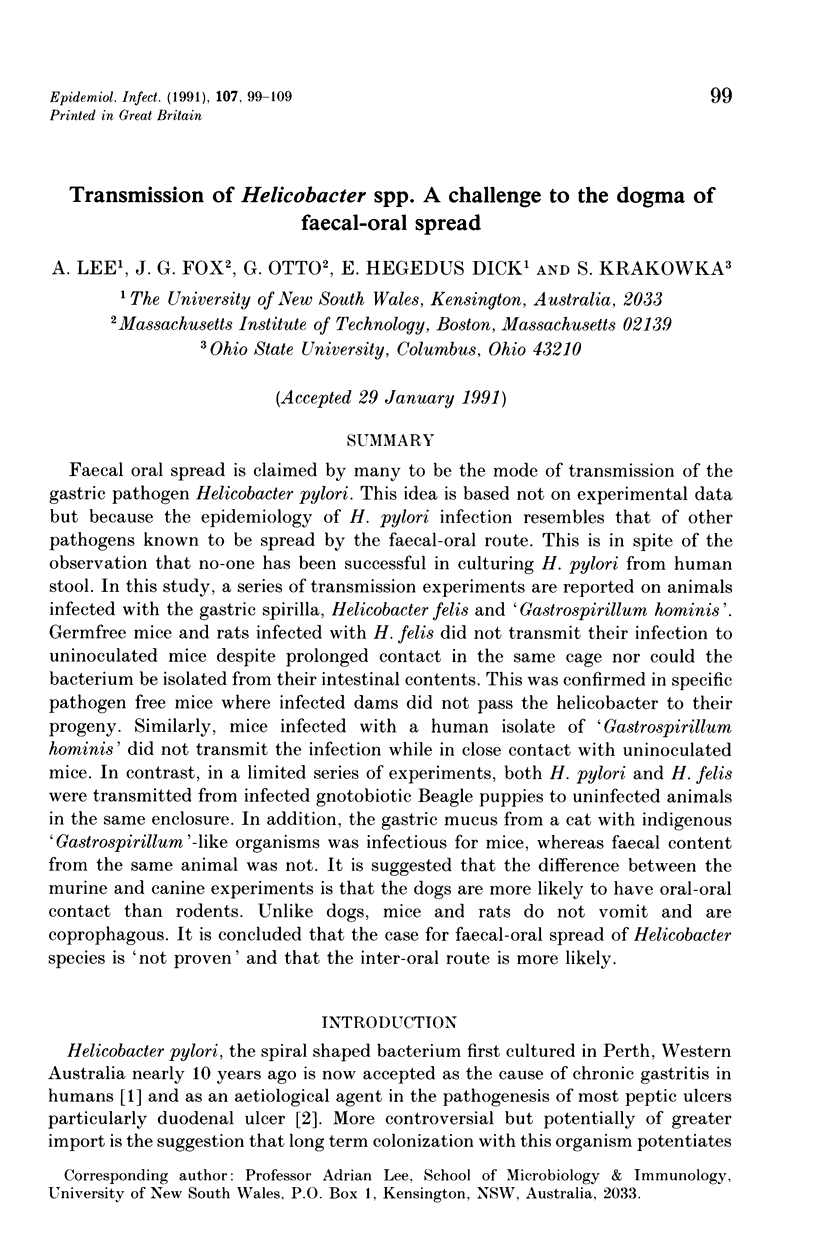
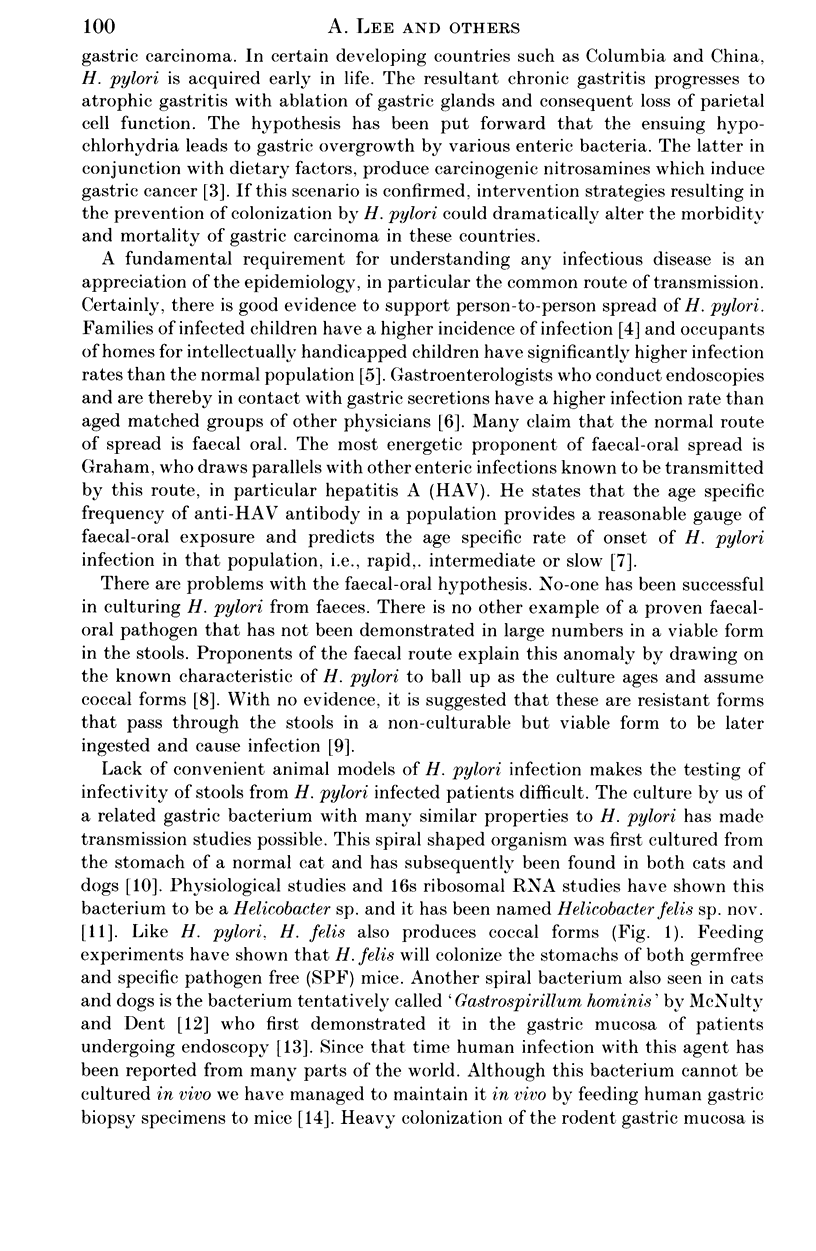
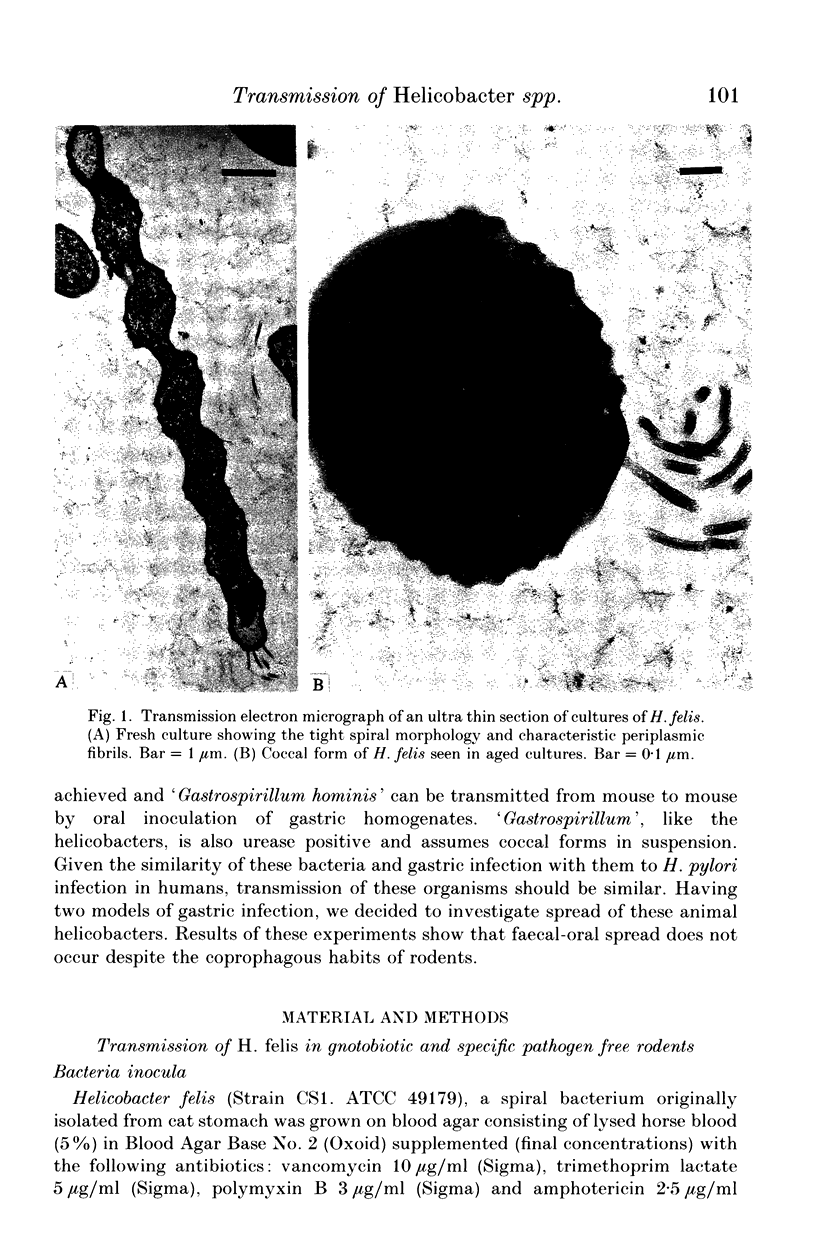
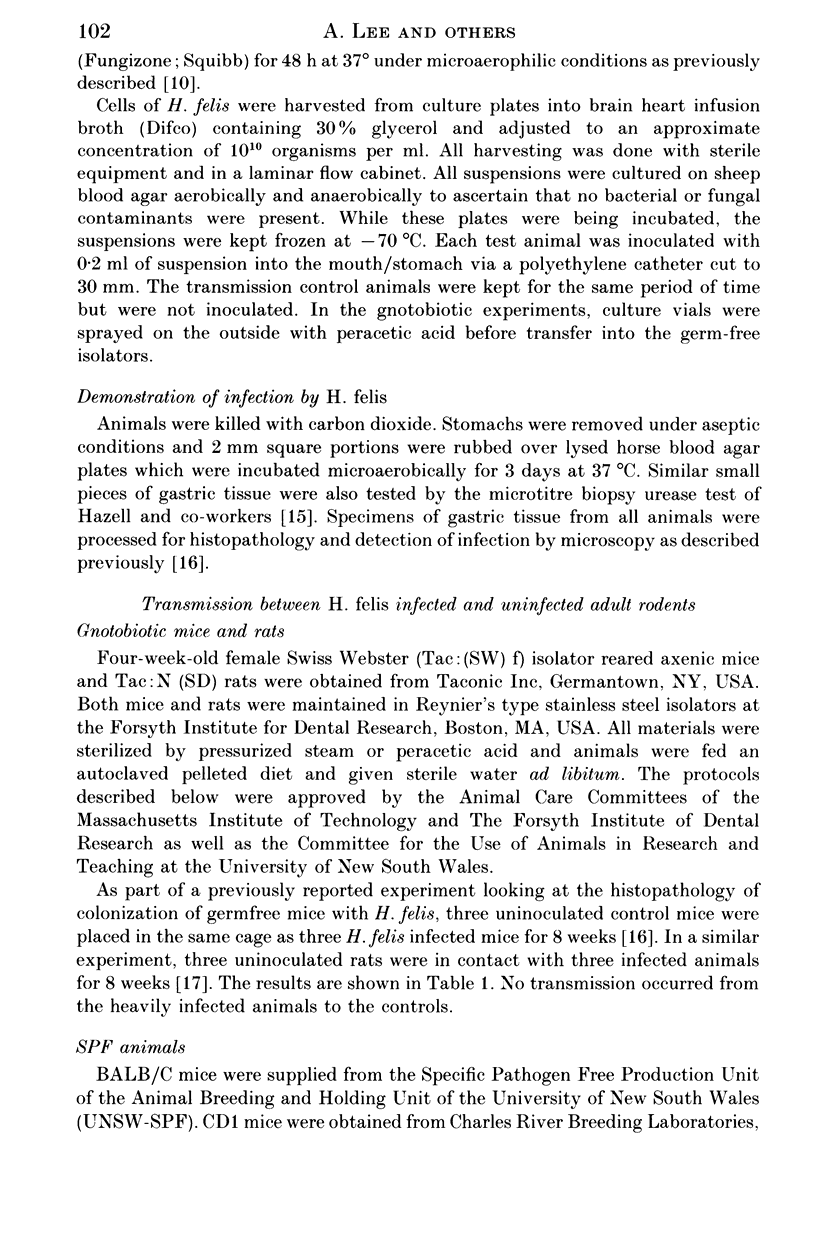
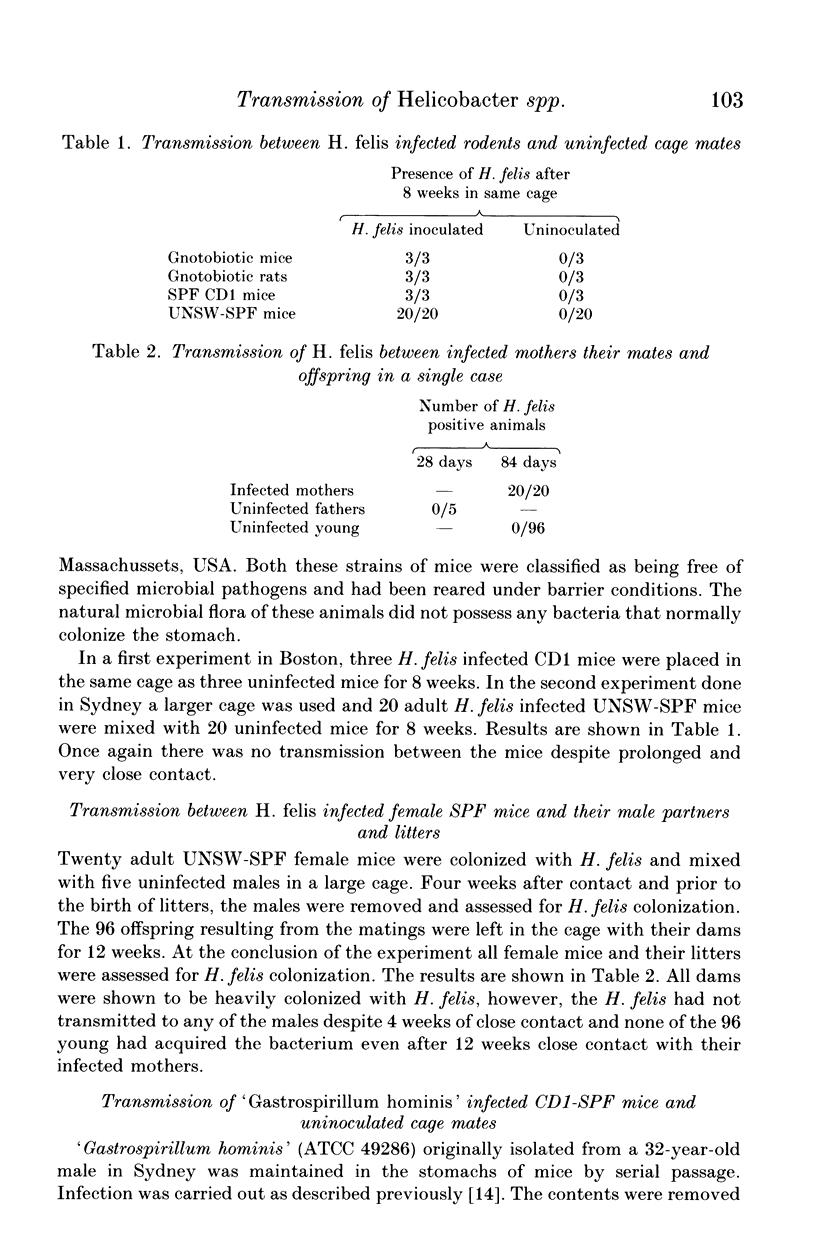
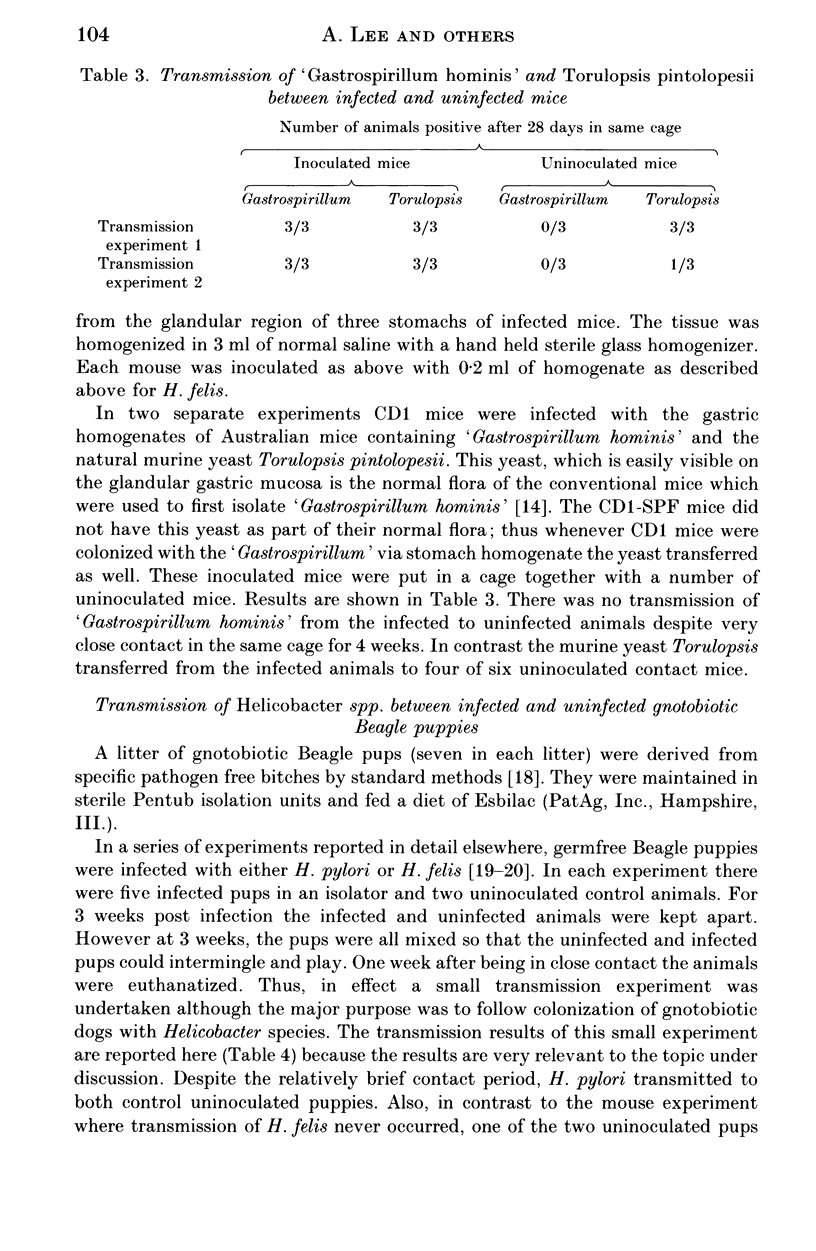
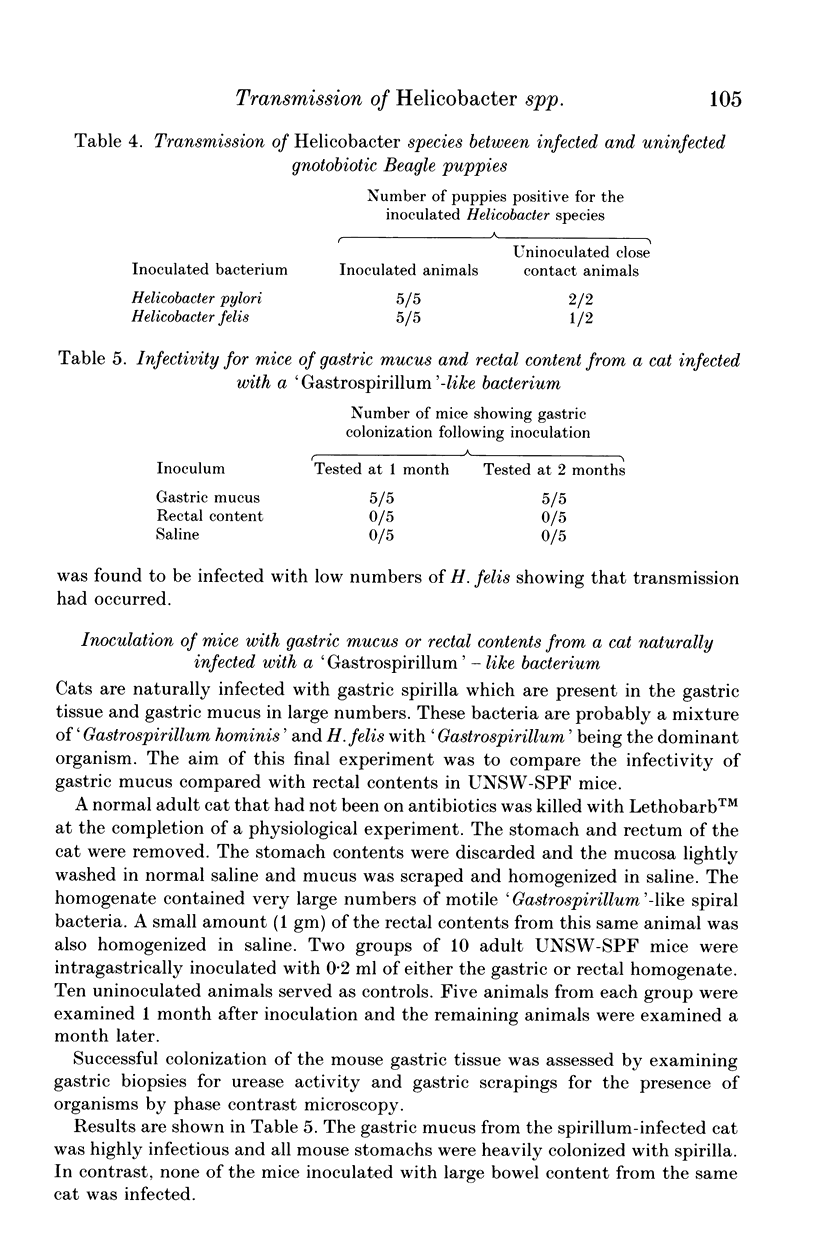
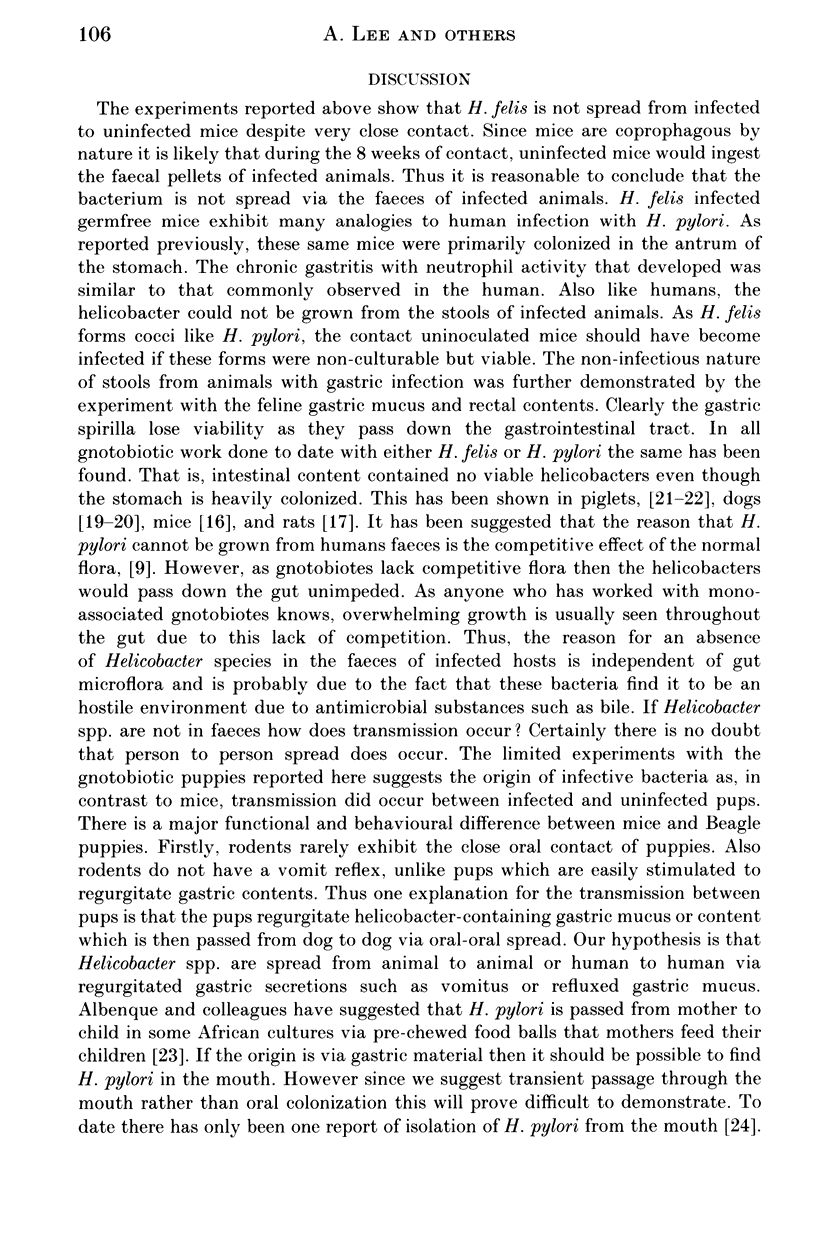
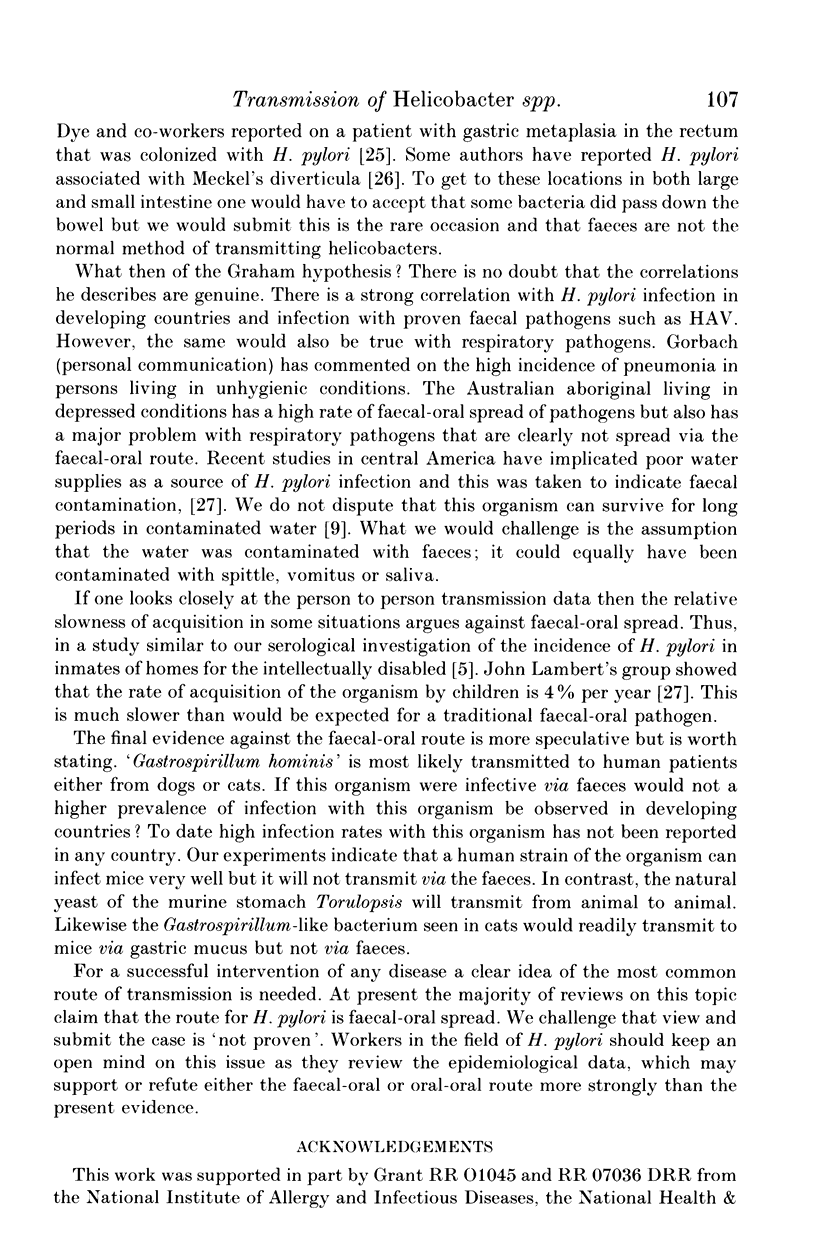
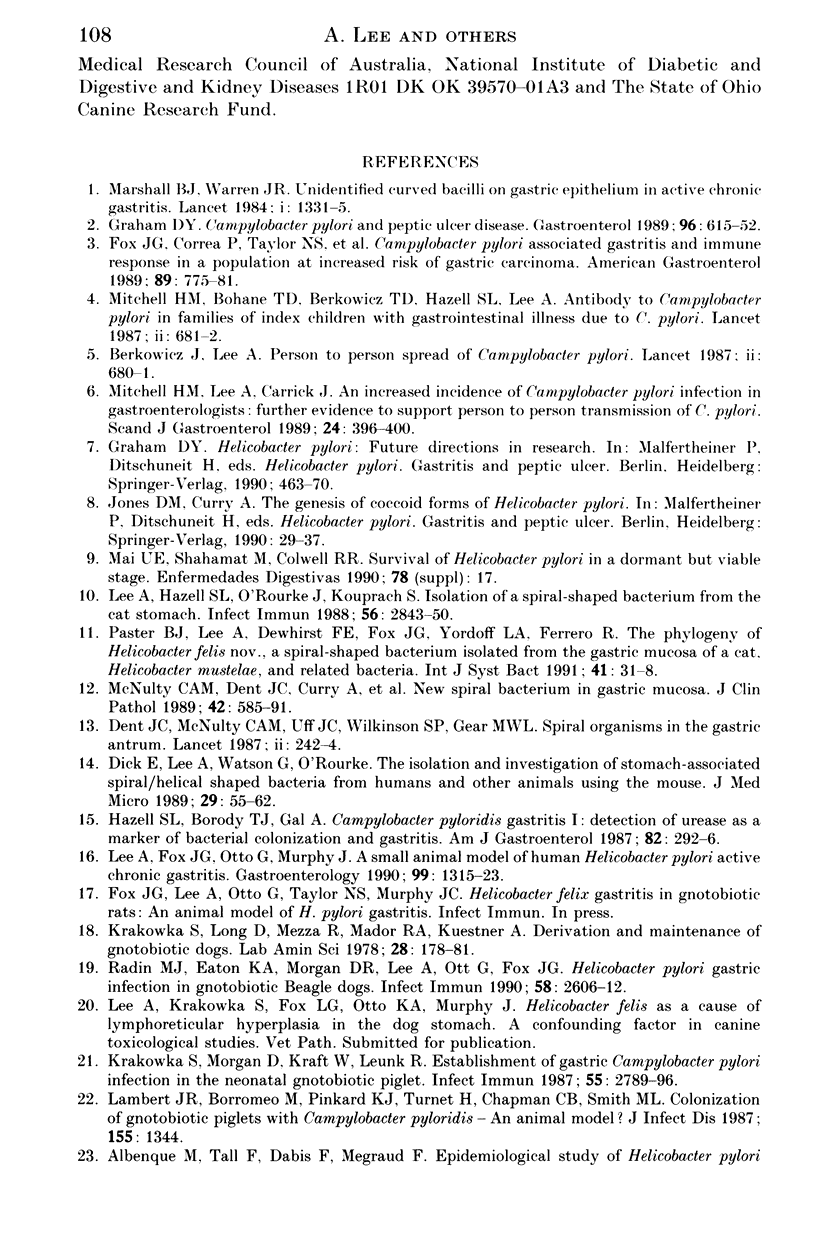
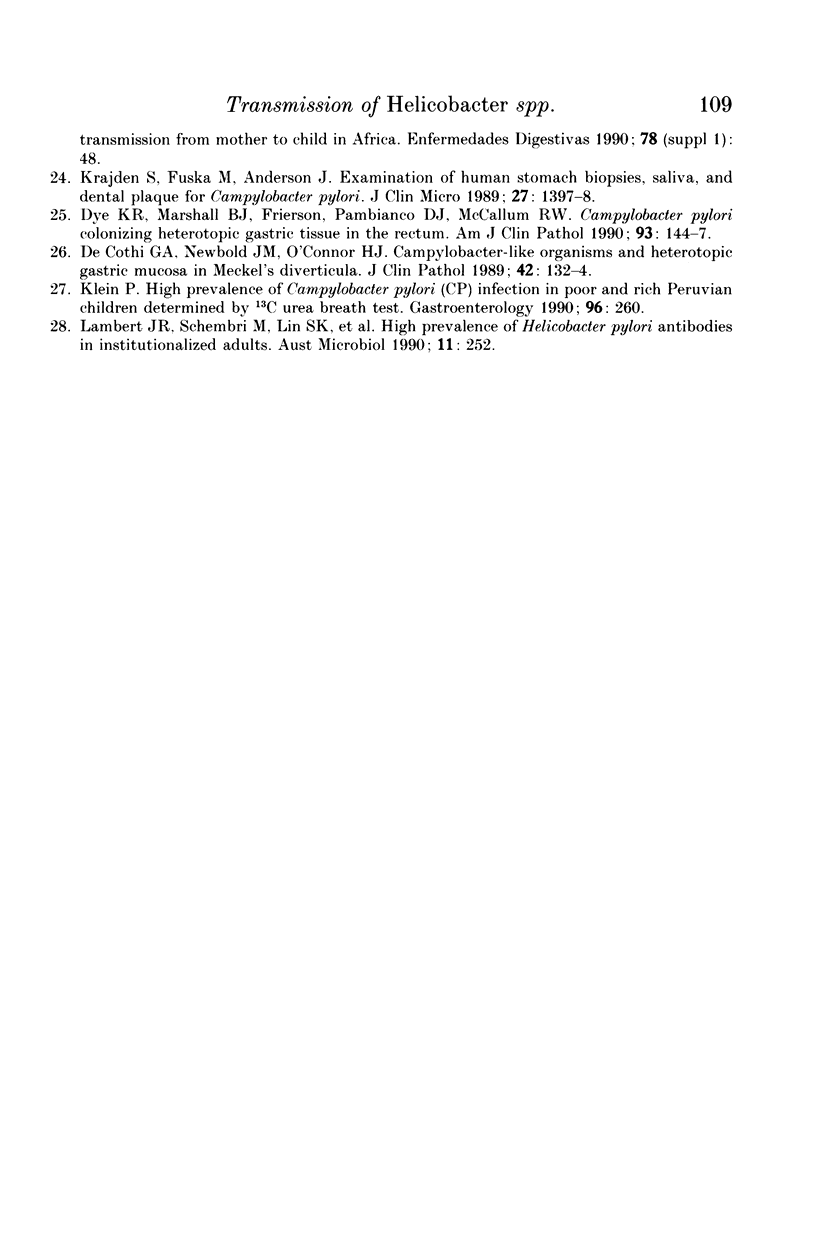
Images in this article
Selected References
These references are in PubMed. This may not be the complete list of references from this article.
- Berkowicz J., Lee A. Person-to-person transmission of Campylobacter pylori. Lancet. 1987 Sep 19;2(8560):680–681. doi: 10.1016/s0140-6736(87)92458-5. [DOI] [PubMed] [Google Scholar]
- Dick E., Lee A., Watson G., O'Rourke J. Use of the mouse for the isolation and investigation of stomach-associated, spiral-helical shaped bacteria from man and other animals. J Med Microbiol. 1989 May;29(1):55–62. doi: 10.1099/00222615-29-1-55. [DOI] [PubMed] [Google Scholar]
- Dye K. R., Marshall B. J., Frierson H. F., Jr, Pambianco D. J., McCallum R. W. Campylobacter pylori colonizing heterotopic gastric tissue in the rectum. Am J Clin Pathol. 1990 Jan;93(1):144–147. doi: 10.1093/ajcp/93.1.144. [DOI] [PubMed] [Google Scholar]
- Fox J. G., Correa P., Taylor N. S., Zavala D., Fontham E., Janney F., Rodriguez E., Hunter F., Diavolitsis S. Campylobacter pylori-associated gastritis and immune response in a population at increased risk of gastric carcinoma. Am J Gastroenterol. 1989 Jul;84(7):775–781. [PubMed] [Google Scholar]
- Hazell S. L., Borody T. J., Gal A., Lee A. Campylobacter pyloridis gastritis I: Detection of urease as a marker of bacterial colonization and gastritis. Am J Gastroenterol. 1987 Apr;82(4):292–296. [PubMed] [Google Scholar]
- Krajden S., Fuksa M., Anderson J., Kempston J., Boccia A., Petrea C., Babida C., Karmali M., Penner J. L. Examination of human stomach biopsies, saliva, and dental plaque for Campylobacter pylori. J Clin Microbiol. 1989 Jun;27(6):1397–1398. doi: 10.1128/jcm.27.6.1397-1398.1989. [DOI] [PMC free article] [PubMed] [Google Scholar]
- Krakowka S., Morgan D. R., Kraft W. G., Leunk R. D. Establishment of gastric Campylobacter pylori infection in the neonatal gnotobiotic piglet. Infect Immun. 1987 Nov;55(11):2789–2796. doi: 10.1128/iai.55.11.2789-2796.1987. [DOI] [PMC free article] [PubMed] [Google Scholar]
- Lambert J. R., Borromeo M., Pinkard K. J., Turner H., Chapman C. B., Smith M. L. Colonization of gnotobiotic piglets with Campylobacter Pyloridis--an animal model? J Infect Dis. 1987 Jun;155(6):1344–1344. doi: 10.1093/infdis/155.6.1344. [DOI] [PubMed] [Google Scholar]
- Lee A., Fox J. G., Otto G., Murphy J. A small animal model of human Helicobacter pylori active chronic gastritis. Gastroenterology. 1990 Nov;99(5):1315–1323. doi: 10.1016/0016-5085(90)91156-z. [DOI] [PubMed] [Google Scholar]
- Lee A., Hazell S. L., O'Rourke J., Kouprach S. Isolation of a spiral-shaped bacterium from the cat stomach. Infect Immun. 1988 Nov;56(11):2843–2850. doi: 10.1128/iai.56.11.2843-2850.1988. [DOI] [PMC free article] [PubMed] [Google Scholar]
- McNulty C. A., Dent J. C., Curry A., Uff J. S., Ford G. A., Gear M. W., Wilkinson S. P. New spiral bacterium in gastric mucosa. J Clin Pathol. 1989 Jun;42(6):585–591. doi: 10.1136/jcp.42.6.585. [DOI] [PMC free article] [PubMed] [Google Scholar]
- Mitchell H. M., Bohane T. D., Berkowicz J., Hazell S. L., Lee A. Antibody to Campylobacter pylori in families of index children with gastrointestinal illness due to C pylori. Lancet. 1987 Sep 19;2(8560):681–682. doi: 10.1016/s0140-6736(87)92459-7. [DOI] [PubMed] [Google Scholar]
- Mitchell H. M., Lee A., Carrick J. Increased incidence of Campylobacter pylori infection in gastroenterologists: further evidence to support person-to-person transmission of C. pylori. Scand J Gastroenterol. 1989 May;24(4):396–400. doi: 10.3109/00365528909093065. [DOI] [PubMed] [Google Scholar]
- Paster B. J., Lee A., Fox J. G., Dewhirst F. E., Tordoff L. A., Fraser G. J., O'Rourke J. L., Taylor N. S., Ferrero R. Phylogeny of Helicobacter felis sp. nov., Helicobacter mustelae, and related bacteria. Int J Syst Bacteriol. 1991 Jan;41(1):31–38. doi: 10.1099/00207713-41-1-31. [DOI] [PubMed] [Google Scholar]
- Radin M. J., Eaton K. A., Krakowka S., Morgan D. R., Lee A., Otto G., Fox J. Helicobacter pylori gastric infection in gnotobiotic beagle dogs. Infect Immun. 1990 Aug;58(8):2606–2612. doi: 10.1128/iai.58.8.2606-2612.1990. [DOI] [PMC free article] [PubMed] [Google Scholar]
- de Cothi G. A., Newbold K. M., O'Connor H. J. Campylobacter-like organisms and heterotopic gastric mucosa in Meckel's diverticula. J Clin Pathol. 1989 Feb;42(2):132–134. doi: 10.1136/jcp.42.2.132. [DOI] [PMC free article] [PubMed] [Google Scholar]



